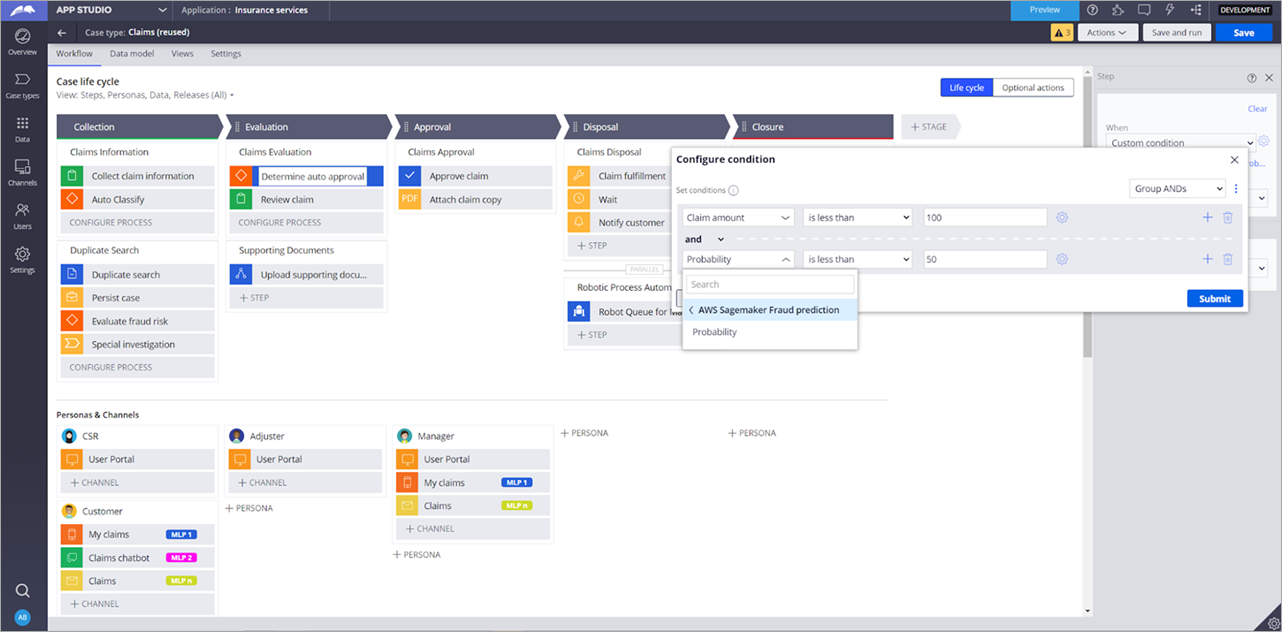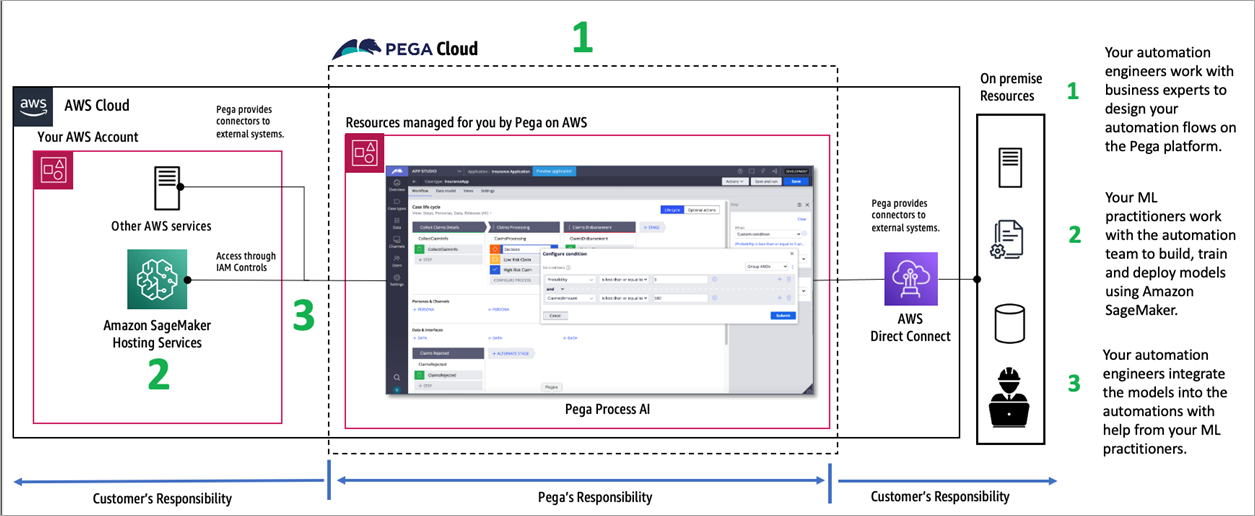AWS Partner Network (APN) Blog
Powering Business Process Automation with Machine Learning Using Pega and Amazon SageMaker
By Andy Bober, Sr. Director Product Management, Intelligent Automation – Pega
By Peter van der Putten, Director AI Lab – Pega
By Daya Thakur, Sr. Partner Solutions Architect – AWS
By Dylan Tong, Global Tech Lead Decision Intelligence – AWS
 |
| Pega |
 |
Through the Pega Platform and Amazon SageMaker, you can easily streamline the development and operationalization of machine learning (ML) models to improve process automation.
Pega is an AWS Partner that provides a low-code platform for delivering artificial intelligence (AI)-powered decision making and workflow automation. Organizations rely on Pega to digitize and transform strategic workflows across onboarding, operations, and exceptions to improve efficiency, increase agility, and accelerate outcomes.
Through interoperability with Amazon SageMaker, Pega has elevated their Intelligent Automation (IA) offering for AWS customers. Today’s organizations want to go all in with AI—and are getting increasingly more value from it—by inserting AI into all kinds of core business processes and customer interactions in operations, services, and marketing.
The collaboration between Pega and Amazon Web Services (AWS) allows customers to combine the strengths of cloud, data, and machine learning with AI-powered decisioning and smart workflow capabilities. This enables customers to operationalize and monetize data and insight, drive process efficiency and effectiveness, and improve customer experience and value.
A Compelling Value Proposition
According to McKinsey’s institute for business and economic research, “about 60% of occupations have at least 30% of their activities automatable.” Most organizations have partially automatable jobs, and this means you could spend more time on dynamic work like complex human interactions and creative problem solving—things you’re valued most for.
Intelligent Automation can be applied to a broad range of scenarios—from straight-through processes that can be automated end-to-end to those that involve the orchestration of workflows, software robots, and human tasks.
According to research conducted by Cognizant and Everest Group, 70% of enterprises that manage to harness IA achieved over 50% in return on investment (ROI), and 25% of enterprises achieve over 100% in ROI, amounting to tens of millions in USD.
Applications exist across industries to improve process automation in order-to-cash, procurement, loan origination, supply chain optimization, customer onboarding, and beyond. Pega has successes with customers in many industries—let’s hone in on an example to better understand how to apply Pega to your business processes.
Insurance Claims Processing
The insurance industry is an area where Pega has delivered successes with customers like Healthfirst. As the largest nonprofit health insurer in New York, Healthfirst experienced a 15% surge in memberships during the pandemic.
Before this Healthfirst used the Pega Platform to modernize its core administration functions: enrollment, claims, authorizations, payments, and provider lifecycle management. Healthfirst’s modern enrollment platform used Pega’s intelligent automation to identify transaction types, route work to the right process, and automate processes as much as possible.
Pega enabled Healthfirst to scale rapidly throughout the pandemic and allow them to improve their claims processing first pass rate to 92%, among many other accomplishments.
Possibilities with ML and Amazon SageMaker
Through Pega’s integration with Amazon SageMaker, insurers are able to streamline the development and operationalization of machine learning models to further improve automation.
For instance, ML models could be deployed to optimize pricing by predicting the risk of applicants—such as the probability that an applicant will claim a large loss in the future—so that insurance premiums can be assigned more efficiently.
Additionally, models could be added to claims processing flows to predict claims that are likely to escalate in complexity and route them to the right adjusters to maximize success rates and minimize re-routing inefficiencies.
Fraud detection models can be added to further improve the ability to surface fraudulent claims. Altogether, the addition of ML can improve straight-through processing rates and profitability.
Figure 1 – Attaching a fraud detection model to a case lifecycle workflow on Pega.
Applying Intelligent Automation in Your Business
Here’s a simple discovery framework that Pega prescribes to customers:
- Identify candidates: The possible processes you can automate are vast, so start by identifying which ones are most critical to your organization. Narrow in on the processes that are automation candidates by surfacing the manual tasks in your current process. You may also consider net-new tasks that aren’t currently feasible—perhaps due to the scale of the required manual labor—but are nonetheless beneficial.
.
As your automation initiatives mature, advanced capabilities like Pega’s process mining can be used to analyze existing processes and uncover new opportunities.
. - Determine what could be automated: The type of processes best suited for automation can be translated into generalizable and repeatable tasks. For instance, a retailer could define an inventory restocking process around a set of rules to decide when to restock and the steps involved in re-ordering stock through supplier’s digital systems. This process involves repeatable logic that can be distilled into an automation workflow.
. - Determine what ML can automate: Knowing what part of your process can be automated by machine learning will help you quantify the potential value of your automation. Here are a couple of common patterns:
.- Decision points: ML models can often be applied at decision points within workflows. For instance, a claims process could use a model to categorize claims that are likely to escalate in complexity and proactively route the work to an appropriately skilled adjuster.
.
A bank, meanwhile, may use a ML model to generate default risk scores for applicants within a loan origination process to decide on whether to pre-qualify them on a loan. A retailer may use an ML-based forecasting model to improve demand forecasting accuracy and use its projections to decide on when to restock inventory.
.
ML-assisted labor: ML models can automate manual labor associated with data extraction, enrichment, and analysis of rich media assets. For instance, ML enables intelligent document processing (IDP) by translating scanned documents into digital forms and extracting metadata from documents, audio, and images to help organize information.
.
ML is used to transcribe audio to text and perform language translation. By embedding these capabilities into business processes, humans only need to intervene when the models can’t complete the tasks with high confidence.
.
For more complex tasks, ML models add value by operating alongside professionals. For instance, ML-enhanced search could surface critical information in a large corpus to facilitate a legal investigation. Models could extract terms of interest, sentiment, and product summaries from text and help legal accelerate e-discovery processes.
.
Additionally, conversational AI capabilities like chatbots could be used to solicit missing information from process participants to further streamline workflows.
.
- Decision points: ML models can often be applied at decision points within workflows. For instance, a claims process could use a model to categorize claims that are likely to escalate in complexity and proactively route the work to an appropriately skilled adjuster.
- Prioritize your use cases: When deciding on which automation to implement first, consider the following:
.- What’s the cost of the process versus the business value it delivers? Processes that fall in the high-cost and high-value quadrant are likely to deliver high ROI.
- Will automating the process allow your team to focus more on high-value and interesting work? Automating tasks in the low-skill and low-interest quadrant can improve employee work satisfaction and improve talent retainment.
- What’s the risk of error in your process? Processes that have a high-error rate and high cost of error should be prioritized. Well-designed automation flows and models can deliver consistency by reducing error rates.
- Have you thought outside the box? Are there new processes that are now possible with IA technology? These types of processes are likely to deliver a competitive advantage.
Start Your Automation Journey on AWS
If you’re ready to explore IA on AWS, follow these steps:
- Follow the above discovery framework to identify your top use cases, define your business objectives, and determine how you will measure success.
. - Prepare your supporting IA infrastructure. The architecture for an IA solution that is powered by Pega Cloud and Amazon SageMaker is as follows.
Figure 2 – Reference Architecture for IA powered by Pega Cloud and Amazon SageMaker.
Pega Cloud is a fully-managed service on AWS. If you’re new to Pega Process AI, you should take these two courses: Pega Process AI Essentials and Using Machine Learning Services. You can then access Pega Cloud through a free trial.
Pega Cloud can connect to your on-premises resources and your AWS resources through AWS Identity and Access Management (IAM) controls you configure in your AWS account. Your ML models will be deployed on Amazon SageMaker from your AWS accounts, and your automations in Pega Cloud can provide access to these hosted models using IAM.
- Translate your business process into an automation workflow on Pega. Delivering your solution will involve a team consisting of automation engineers that build and manage your automations on the Pega Platform alongside business experts. Eventually, your team will also require ML practitioners that will help build and operationalize your ML models on Amazon SageMaker.
.
It’s generally a good idea to build your automation without ML models in your first iteration unless they’re necessary to achieve your most basic business objectives. By doing so, you have a way to baseline the performance of your automation, get a sense of which models to build first, and measure the gains from your models.
.
Furthermore, a first version of your automation provides a base for handling cold-start processes. At launch, you may not have collected the data required for training effective models. Thus, your automation may initially orchestrate manual tasks or rely on subject-matter-expert designed rules. Once you’ve acquired high-quality datasets, ML models can be trained to replace manual or sub-optimal steps in your business process.
.
This is an iterative step and you should ensure you’re collecting the right success metrics to help identify and prioritize opportunities to continuously improve your automations.
. - Build and deploy your ML models on Amazon SageMaker. Amazon SageMaker is a machine learning service designed to help analysts, developers, and data scientists build and operationalize ML models. Follow this guide to get started on your journey if you’re new to Amazon SageMaker.
.
Before you start building your models for your Pega automations, familiarize yourself with the frameworks and the model input and output formats supported by Pega. Models that are deployed on SageMaker as hosted endpoints can be integrated into your Pega automations through the procedure documentation.
. - Build quality control mechanisms for your models. As a best practice, you should build mechanisms for:
-
- Human review: The goal of IA is to minimize human intervention, but it doesn’t mean you should or could eliminate human involvement. ML models are probabilistic, and if your model makes a low-confidence prediction, it’s advised to route the decision for human review. Build in logic to your workflow to evaluate confidence thresholds. Start by passing through high-confidence predictions and consider lowering the threshold to improve the pass-through rate if the model proves trustworthy in production.
. - Monitoring: ML models generally degrade in performance over time. Models are trained on historic data to discover latent patterns that enable them to accurately predict the future, but as environments change the models have to be re-trained to re-adapt. For instance, product recommender models have to be re-trained to maintain peak performance as product catalogs and consumer behavior evolve.
.
Amazon SageMaker provides model monitoring capabilities that can help you detect early signs of model degradation. It’s recommended you deploy your models with appropriate monitoring capabilities to ensure your product models continue to meet quality standards.
. - Continuous improvement: You should build in mechanisms to continually improve the quality of your models. As part of the human review process, you should also build data capture feedback. For instance, if your credit risk model in your loan application workflow predicts that an applicant is high-risk but with low confidence, your workflow should route the application for expert review and also solicit feedback and capture outcomes—this data can be used to re-train and improve the model.
. - Guardrails: You should build in guardrails to ensure your workflows fail gracefully and mitigate the risk of improper use of your models, or models that perform unexpectedly poorly in production. For instance, if you want to mitigate the risk of change from introducing new models, consider running parallel workflows that serve the new challenger models on a subset of your consumer base before promoting the workflow for broader use.
.
This pattern also makes sense for cold-start periods. Initially, you may not have the data required to build an effective ML model, so you might want to use this design to serve challenger ML models alongside a rules-based model to facilitate cold starts. Alternatively, you could manage deployment best practices at the model-level with the help of Amazon SageMaker’s deployment guardrails.
- Human review: The goal of IA is to minimize human intervention, but it doesn’t mean you should or could eliminate human involvement. ML models are probabilistic, and if your model makes a low-confidence prediction, it’s advised to route the decision for human review. Build in logic to your workflow to evaluate confidence thresholds. Start by passing through high-confidence predictions and consider lowering the threshold to improve the pass-through rate if the model proves trustworthy in production.
Conclusion
Machine learning offers opportunities to elevate your business process automation. Together, Pega and Amazon SageMaker empower your organization to accelerate the development and operationalization of Intelligent Automation solutions.
Get started today by taking the Pega Process AI Essentials and Using Machine Learning Services courses to learn more. Then, get access to Pega Cloud through a free trial.
Need more information on how to integrate Amazon SageMaker hosted models with Pega? Refer to the Pega documentation:
- Enrich your decision strategies with Amazon SageMaker predictive models
- Supported Amazon SageMaker models
Pega – AWS Partner Spotlight
Pega is an AWS Partner that provides a low-code platform for delivering artificial intelligence (AI)-powered decision making and workflow automation.


